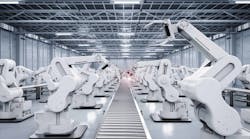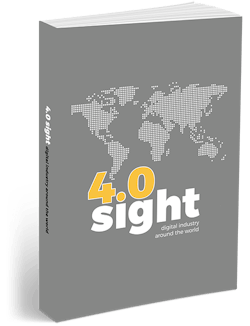Industry 4.0 has become a phrase we love to hate. Used to describe everything from modular automation to cloud computing, the term has come to mean different things to different people. When the phrase Industry 4.0 was first coined at a press conference at Hannover Fair in 2011, few realized the lasting impact it would have on industry as we know it. Not only did it set into motion a series of government initiatives in Germany, in the form of the platform Industry 4.0, it also spurred the rest of the world to take action.
The UK, for example, launched its industrial strategy focused on pushing the boundaries of artificial intelligence and renewable energy. The strategy will see investment in many new areas of technology, including a promised £400 million investment in electric vehicle charging infrastructure and £176 million in 5G mobile connectivity.
Elsewhere, the U.S. has already used digitalization to help itself halt a two-decade-long decline in its manufacturing sector—a period marred by millions of job losses. The Manufacturing USA program has introduced technology institutes that are breaking ground in the research and commercialization of technologies such as clean energy, materials and composites, semiconductors, and flexible hybrid electronics.
A Fragmented Industry
Despite the speed of digitalization in some countries, others are still in their infancy. For example, Italy only launched an official initiative in the last few years and has yet to attract the necessary funding. Similarly, while France has made good progress in the development of autonomous energy-harvesting sensors, it must overcome its technology skills gap before it can create a truly prosperous digital industry.
What these challenges show is the diverse range of journeys that different countries are taking to digitalize. If not addressed, the resulting fragmentation between nations may lead to the stunted growth of change initiatives around the world. To tackle this, truly decisive leadership is necessary to provide a coordinated approach.
Part of the reason for this fragmentation is that successive Industrial Revolutions are getting shorter in duration. Whereas the First Industrial Revolution (which used steam power) lasted around 80 years, the Second (which was responsible for mass production) lasted around 44. The Third (which is commonly known as the Information Age) lasted around 31 years.
Digital Industry Around the World
The book 4.0 Sight – Digital Industry Around the World covers both the role of technology and people in the future of manufacturing and how it is reflected in different countries.
The book, called 4.0 Sight – Digital Industry Around the World, explains what manufacturers need to know about different global initiatives such as Industry 4.0, Made in China 2025, and L’usine du future, and how to apply the ideas to their own business models. Each chapter explores the role of technology in Industry 4.0 and predicts which technologies will shape the future of manufacturing, such as deep learning, modular automation, and integrated platforms.
The book also explores how these technologies, which also include artificial intelligence, remote monitoring, and additive manufacturing, will be crucial as we develop new ways of automating industry and the workforce of the future. Developments in advanced manufacturing technologies are also discussed.
The book features interviews with a range of experts in the industry, such as Neil Mead, editor of Automation magazine; Steve Ward, applications engineering director at GE; and Nigel Smith, CEO of TM Robotics. Each shares a perspective on how these global initiatives are changing the manufacturing industry and how businesses can adapt to remain competitive.
“We keep hearing about the next industrial revolution, but no one has put this into context to explain exactly what it means for companies around the world,” explained Jonathan Wilkins, marketing director of EU Automation and co-author of 4.0 Sight. “As a result, many manufacturers are scrambling to digitalize their operations often without a true appreciation of where the industry is headed.
“We wrote 4.0 Sight to eliminate any confusion for manufacturers. It acts as a travel guide to Industry 4.0 across the world,” added Wilkins. “Each country has a different focus in its aim to digitalize. For example, Japan faces an aging workforce and population, China is planning on becoming the world’s strongest economy, and the UK wants to position itself as a leader in AI. Because the speed of development varies by country, we’ve seen the same Industrial Revolution referred to by different names.
4.0 Sight covers both the role of technology and people in the future of manufacturing. Experts give their perspective on the skills gap, engineers at Renishaw give their perspective on the gender gap, and we explore how automation will change the nature of human jobs in manufacturing.
Jonathan Wilkins is marketing director at EU Automation.


